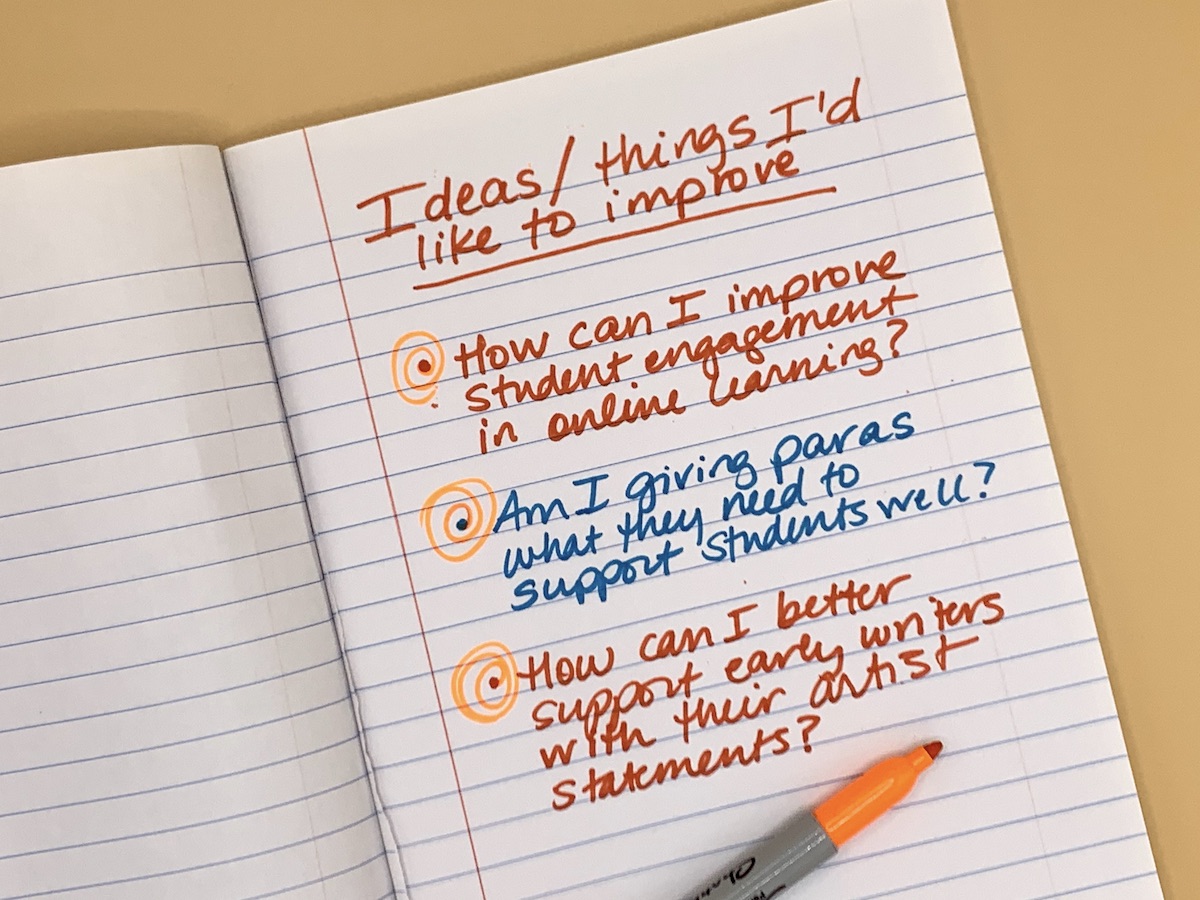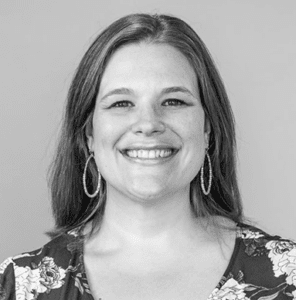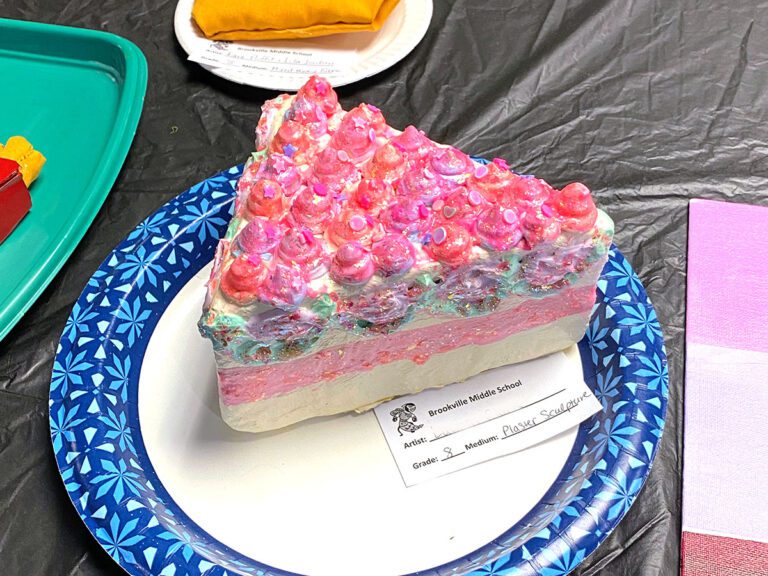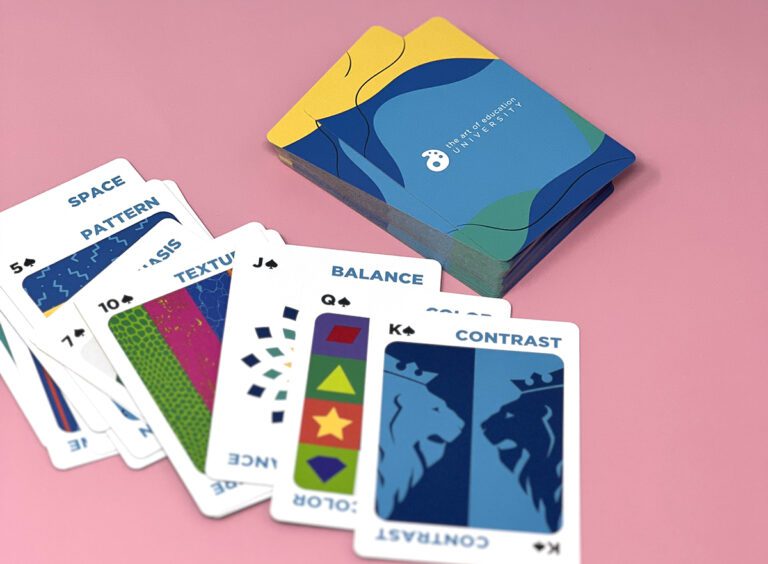People conduct research to gain new knowledge or deeper understandings of a topic they are passionate about. Traditionally, educational research is conducted by university-level researchers or other professionals who are outsiders in K-12 school settings. Traditional educational research is usually a top-down approach to develop theory.
Action research positions teachers as experts and researchers.
In contrast, action research starts with educators who see problems they would like to address in their own classrooms, schools, and districts. Teachers are viewed as experts, seeking to improve their practice and students’ learning experiences. This defining quality of action research is central to art educators’ experience completing their Capstone Research in AOEU’s master’s degree program for Art Education or Curriculum & Instruction. However, any art educator can conduct action research to improve their practice and student learning.

Sarah Efrat Efron and Ruth Ravid explain the unique characteristics of action research in their 2020 book, Action Research Research in Education: A Practical Guide. They describe action research as “constructivist, situational, practical, systemic, and cyclical.” Let’s break down each of these points with an eye toward art education.
Action research is constructivist.
Constructivism recognizes that individuals develop their ideas based on previous experience and knowledge. Rather than being recipients of research findings that we are to apply in our classrooms, art educators conducting action research use a constructivist approach.
Read How to Look at Research with a Critical Eye for more.
Art educators’ familiarity with a setting is valuable as we choose and draw upon well-vetted, relevant research literature to address questions and challenges in our personal teaching practice.
Action research is tailored to the situation.
The primary aim of action research is to affect one’s own practice and student learning. As Evron and Ravid acknowledge, as much as most teachers would like to find proven solutions, our classrooms will always have unique students in unique contexts.
Read How to Get Your Research Published for more.
For example, you might experience varying levels of success with research-supported engagement strategies, depending on what is happening for students physically and emotionally from day to day. The strategies you identify for designing successful collaborations with visiting artists might not work in the same way when you move to a different school with different resources. Even when published, action research is meant to be understood with the context in mind and not expected to be generalizable. This is viewed as a weakness in circles that prioritize replicability and generalizable findings.
Action research is practical.
Action research is meant to have an immediate impact on one’s practice and student learning. It is not focused on the development of new theories. In fact, action research data collection is often integrated into art educators’ regular teaching practices. This happens when we draw upon personal observations, conduct systematic reflections, and/or use existing assessments for data collection.

These elements, among others, are part of self-exempt research practice under the Revised Common Rule for the Federal Policy for the Protection of Human Subjects.
Note: student-created artifacts should not be reproduced when reporting on the findings of self-exempt research.
Action research is systematic.
Art educators who conduct action research aim to produce trustworthy and meaningful results. We read, plan, and identify research methodology that is well suited to our research questions and contexts. We still draw upon well-vetted practices that fall under the general categories of quantitative, qualitative, and mixed methods research. We also seek to ensure that their data collection tools and data analysis process will mitigate bias and support the study’s reliability, validity, or trustworthiness.
Action research is cyclical.
Just as new groups of students cycle through our art classrooms each year, action research is cyclical. Evron and Ravid summarize six steps in the action research cycle. These steps include identifying a problem, gathering background information, designing a study, collecting data, analyzing and interpreting data, and implementing and sharing findings.
Read 8 Habits of Successful Researchers for more.
Doing Action Research in the Art Classroom, by Amy Pfeiler-Wunder and Diane Jaquith, and How Action Research Can Improve Your Teaching by Alexandra Overby show two additional models of action research. In each model, the steps in the action cycle are somewhat fluid. For example, through reading existing literature on a topic, you might choose to revise the question guiding your inquiry. With each iteration of the cycle, art educators gain further insight into the challenges we wish to address. Each iteration also gives us the opportunity to formulate new questions for further cycles of action research.

Action research can go beyond your own classroom.
Collaborative Action Research and Participatory Action Research are two specific forms of action research that go beyond an individual teacher’s classroom. In Collaborative Action Research, a group of educators in a given context choose to work together to investigate a topic that crosses grade levels or disciplines. Together, they decide how the findings should affect their program or school.
In Participatory Action Research, researchers and school practitioners work together as partners with a social-justice orientation. Together, they seek to create change and address larger systemic equity issues. If you aspire to affect larger settings, consider starting small with a cycle of action research in your own art classroom. It can be valuable to share a successful local example and help others envision the process and work as you seek to impact your department, district, or community.
As art educators, we are always looking for ways to improve and reinvent what we do in the art room. Action research creates one more opportunity to incorporate that change immediately and to impact student learning now. Whether you engage your colleagues or work independently, conducting action research is a way to use your experience and impact students within your unique circumstances.
How have you seen your colleagues engage in action research?
What aspects of action research already align with your teaching practice?
Magazine articles and podcasts are opinions of professional education contributors and do not necessarily represent the position of the Art of Education University (AOEU) or its academic offerings. Contributors use terms in the way they are most often talked about in the scope of their educational experiences.





